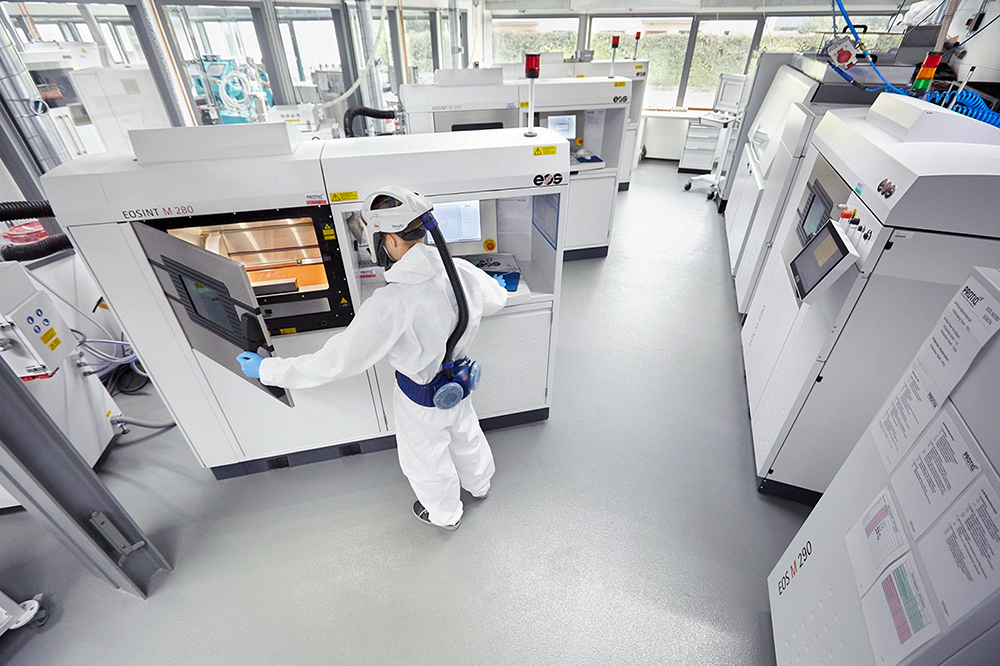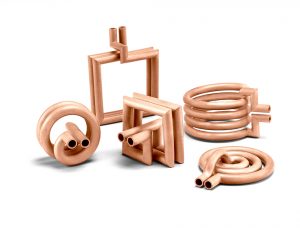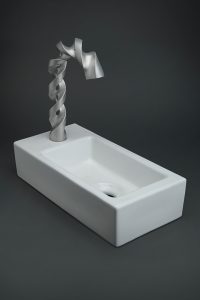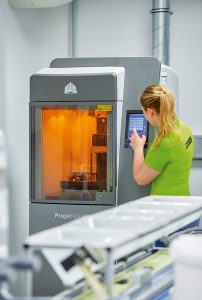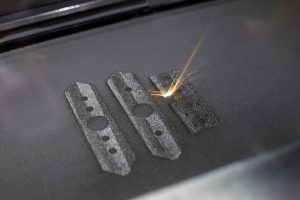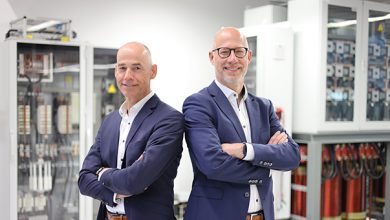When it comes to building complex structures that are supported on top of each other in wafer-thin layers, additive manufacturing comes into play. At Phoenix Contact, the name Protiq comes to mind. And when it comes to the business models behind the technology and sales expertise, Stefan de Groot is the right man.
“I’m rarely completely flat and exhausted,” laughs the 36-year-old industrial engineer. “However, there are definitely situations where the phone rings on Friday afternoons and a big order blows up the weekend.” But, as Stefan de Groot assures us during an interview at the Phoenix Contact subsidiary, this is the exception rather than the rule, despite the virulent and constantly growing order situation.
Stefan de Groot is, as he describes it himself, a typical employee at 3D printing specialist Protiq. A qualified engineer who is passionate about additive manufacturing. He knows his way around machine building and helped to develop the 3D printers and their technology. But he has now also helped to set up the company’s own digital marketplace and is deeply involved in sales issues, which he is now responsible for.
Barely started, already fired
De Groot started in 2016 in the Rapid Solutions department in Phoenix Contact’s own tool shop. “But after three months it was over again. That’s when Protiq GmbH was spun off and put on its own entrepreneurial footing.” Since then, the likeable 3D printer has been an ex-colleague, albeit on the same company premises.
“Of course, the start was not as bumpy as with many other start-ups,” says de Groot, describing the early days. “We had a client who kept us very busy.” But right from the start, it was planned that “Protiq”, as it is known, would not only develop in the area of technology. “Just under a year later, in November 2017, we launched our Marketplace, our digital distribution medium. And external orders from customers now exceed the orders we receive from the parent company.” Since then, Protiq has developed rapidly in two respects.
Technological pioneer
Protiq has been making headlines for years when it comes to new materials that can then be processed using 3D printing. You can see Stefan de Groot’s enthusiasm when he talks about his career. “I myself was initially at home on and in the machine. When I started in 2016, my field was really in production, especially in the area of metals. And the complete program: system preparation, component post-processing, powder handling, powder feeding.”
Initially, Phoenix Contact’s own tool shop was the driving force behind the further development of additive manufacturing. This involved topics such as conformal cooling, which can reduce process times in production, for example in the plastic injection molding process, or the production of forming tools that can be used to print test samples. “But it didn’t stop there, because it is typical of Phoenix Contact’s DNA to look for new processes and new solutions. What can we develop that didn’t exist before?”
At the time, there were already many standard materials, such as the MS1 1.2709 tool steel in the metal laser melting sector, which had established itself in additive manufacturing. The same was true in the plastics sector, where certain polyamides, such as nylon, are processed using laser sintering. “At some point, we wanted to be able to process conventional series materials, which we have been using for years in our parent company, in additive manufacturing as well. These materials have better, more durable properties. And of course, as an electrical engineering company, we also wanted to make our most important metal, copper, printable.”
There’s no such thing as impossible
“In 2010, when we started, copper was not considered processable in 3D printing. So we developed a process that allowed us to process copper with our machines. We were able to present this in 2013. Market competitors, who now also offer copper printing, started doing this in 2018/19.” There is a certain amount of pride in de Groot’s description: “This sets us fundamentally apart from our competitors. We have developed our own systems for both metal and plastic and started out on a greenfield site. And we asked ourselves what a development and qualification system needs to have in order to be able to process materials that cannot actually be processed.”
In order to print materials that previously seemed unsuitable for this, the experts at Protiq began to focus intensively on their properties and, above all, the available states of aggregation. In order to be able to actually print wafer-thin layers and fuse them with the laser, the layer to be applied must be wafer-thin. In the powder bed process in particular, which is Protiq’s specialty, the material must have a specific moisture content and be homogeneous. Especially in the plastics sector, the pourability that needs to be achieved in this way is a real challenge. “We have carried out real basic research together with major material manufacturers,” says Stefan de Groot, describing the efforts involved.
With success, as Protiq was the first company to be able to print copper. And the Blomberg-based company followed up with zinc and high-strength tool steel, underpinning its claim to be one of the flagship companies in additive manufacturing.
The Internet of Print
Stefan de Groot’s area of responsibility also changed with the technological development. “I became Technology Manager, so I was responsible for process and material development and was heavily involved in project support for customers.” At the end of 2017, the digital channel was expanded into a real sales channel, the Protiq Marketplace. This was a big step for all customers who wanted to access additive manufacturing products. Right from the start, the Marketplace was intended as a collection point for a wide range of 3D printing experts and not just for distributing the company’s own services.
“Since then, we have combined two processes. We are still a supplier of 3D printed products. We are talking about our analog area. But we are also the operator of the Marketplace and are constantly expanding this platform, i.e. developing our digital business.” Even Phoenix Contact’s own machine and tool shop uses the Marketplace when necessary to print spare parts or prototypes.
Quality wins
There are now 40 suppliers on the Marketplace, and the trend is growing. The range is broad. In addition to the company’s own specialties, you can also find ceramics or glass from other companies. “We are talking about partners here. In order to attract new partners, we have developed an onboarding process that we go through together with interested companies. We are guided by strict standards. Our basic requirement is ISO 9001 certification. And we conduct our own audits with the providers. This is how we ensure the quality of the portfolio.”
If a company needs additive manufacturing products and looks at the marketplace, it will often receive several offers. How do you negotiate between suppliers to avoid ruinous price wars? “Of course, it’s also about the price,” says de Groot, describing day-to-day business. “But our end customer structure is such that it’s more about factors such as delivery times and quantities or quality. That’s where the suppliers differ. Of course, we sometimes lose an order ourselves. Each participating company has its own pricing, its own processes. It’s every man for himself.”
Transparency counts
There is now more than one digital platform on which 3D printers offer their skills. But Stefan de Groot is confident: “We work with the greatest possible transparency for partners and end customers. This is particularly important in an industrial environment. This is often quite opaque with other platforms. And we are constantly developing the Marketplace further, for example with special configurators for inductors, gears, orthopaedic shoe lasts or housing covers. All the end customer has to do is enter the details of the component they need and the configurator turns it into a 3D printable data set. This means that they can order without much design knowledge. Live pricing runs the whole time. If the customer enters changes to their component, they immediately have a cost overview of this change. In addition, a scale effect is embedded so that the number of units is also included in the price.”
Another special feature of the Marketplace is Protiq Purchase, which caters to the needs of established key accounts. De Groot explains: “If, for example, they see that there are partners who work with materials that we as Protiq do not offer, such as ceramics or glass, then we take over the complex supplier creation process for these customers in a new Marketplace function, which can cost several thousand euros per supplier for these large corporations. In the material selection process, the customer has the option of having supplier x, y or z manufacture the component. But the invoice comes from Protiq so that no new supplier has to be created in their accounting department. We then receive the components, check them here and send them on.”
De Groot is correspondingly confident when it comes to the positioning of the marketplace: “Of course, price is an important manipulated variable. But for our customers who use first level support in particular, it’s our know-how and our expertise in consulting that counts. This is also a USP of our marketplace. Our experts know the machines, the processes and the materials. They are all part of additive manufacturing. Only colleagues who are deeply involved in the subject matter work here.”
The toolmaking spin-off from the parent company in Blomberg has become a subsidiary with an exciting strategy of analog production and digital business models. And anyone who has the pleasure of talking to Stefan de Groot about the prospects of 3D printing in industrial production will have an inkling that this development is far from over.
Protiq
News – Protiq prints copper
News – Protiq prints zinc
The printed digital twin
